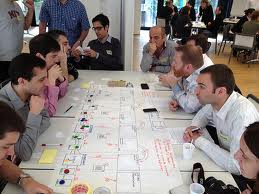
What Is the Bullwhip Effect?
The bullwhip effect in supply chains is the increase in order fluctuations as one moves upstream. It starts with a small signal in the consumption of goods by a downstream step.
This small signal is misinterpreted by every other step, leading to distortion of the actual customer demand in the supply chain.
Since customer demand is not constant over the short term, businesses tend to make forecasts based on historical records and statistical calculations. These forecasts are rarely accurate, which results in businesses carrying safety stock to mitigate against the forecasting errors.
Every player along the value stream will similarly keep this buffer, amplifying the variations even more.
Causes of the Bullwhip Effect
Retailers may misinterpret a small increase in customer purchases as an indication of future demand. This will make them order higher amounts in anticipation of a rise in demand. The amounts ordered are meant to cover any future demand together with the current consumption. This signal of consumption is transmitted upstream to the distributors and manufacturers who draw the same wrong conclusions.
The amplification of the orders increases as one goes upstream. This is because the players at a higher level of the supply chain operate on a larger scale than those lower down. When the anticipated sales at the retail level fail to materialize, the distributor gets stuck with too much inventory. This forces the distributor to reduce the orders that he will give the manufacturer, who will in turn reduce the amount produced.
- Promotions and Discounts increase purchases temporarily and this sends a wrong signal to the distributors and manufacturers that the consumption has increased.
- Order batching is the consolidation of orders into one main order that is sent to the distributor once every month or every two weeks. This infrequent ordering creates spikes in the supply chain that are sometimes misread to mean there is an increase in consumption.
- Pushing of orders by sales people, by giving temporary incentives so that they can meet their quarterly targets, causes excess supply at the end of the quarter.
- Introduction of new products in the market creates a sharp increase in orders from the retailers and distributors. This distorts the actual demand for the product which leads the manufacturer to produce even more. After the initial excitement of the product launch dies down, a large stock of unsold goods remains at various sections of the supply chain because the real customer demand is much lower than what was produced.
Bullwhip Effect Explained
The video above is a simple explanation of how the bullwhip effect occurs in a typical supply chain situation. A small signal at the customer side of the supply chain triggers a disproportionate reaction upstream. All the players react with their own interests in mind and these reactions are misread as one goes upstream.
The Beer Game
The Beer Game
This is a famous game that is used in universities and companies to explain the bullwhip effect. It is a role-playing game that explores the typical supply chain coordination problems. It helps in understanding the importance of information in a supply chain.
The main purpose of the game is to explain the need for supply chain coordination and management. By understanding the supply chain as a complete system, the players learn:
- how individual components of a supply chain affect each other
- why sub-optimization does not yield the best results
- optimization of the system as a whole
- the role of Information Communication Technology (ICT)
Setting up the Beer Game
There are four stages that represent a typical supply chain:
- Retailer—usually given the colour pink, this is the point of contact with the final customer.
- Wholesaler—must meet the retailer’s order and is normally orange in colour
- Distributor—fulfils the wholesaler’s orders and is allocated the color green.
- Manufacturer—must meet the distributor’s order by producing as per the demand and allocated the color blue.
Playing the Beer Distribution Game
The Beer Game is played by groups of three people who sit around a table that represents any of the four stages of the supply chain. Each table is laid out in the following manner:
- Order Inbox that comes from the preceding stage
- Order Outbox that goes to the subsequent stage
- Receiving Area that comes from the preceding stage
- Dispatch Area that goes to the subsequent stage
There is a delivery and production lead time of two weeks each which is represented by placing two small placeholders in between the supply chain stages.
Beer Game Rules
Beer Game is played over several weeks where on each a group plays by following the sequence listed below:
- Delivery receipt
- Order receipt
- Shipping quantity calculation
- New order consensus
The main aim of the game is to minimize costs, of which there are two types:
- Inventory costs
- Backorder costs
Backorders occur when an order cannot be fulfilled, in which they are forwarded to the following week.
More rules:
- Supply chain groups are not supposed to talk to each other.
- The real customer demand is known only to the retailer.
- All orders must be supplied if there is stock.
- If the stock is not available, the order must be supplied in the next week as a backorder.
- Always add new deliveries to the old inventory in stock.
- The order to ship must include any backorder plus the new order.
- Supply what is available if the stocks are not sufficient.
- Accurately calculate the back-orders.
- New inventory quantity is the available stock minus the number delivered.
- Place a new order and forward it to the next stage.

